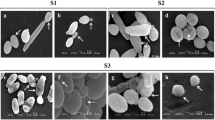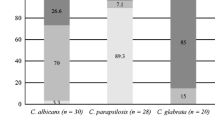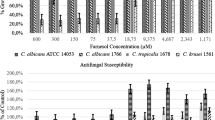Abstract
Candida parapsilosis is yeast capable of forming biofilms on medical devices. Novel approaches for the prevention and eradication of the biofilms are desired. This study investigated the anticandidal activity of sixteen essential oils on planktonic and biofilm cultures of C. parapsilosis complex. We used molecular tools, enumeration of colony-forming units, the colourimetric MTT assay, scanning electron microscopy (SEM) and a chequerboard assay coupled with software analyses to evaluate the growth kinetics, architecture, inhibition and reduction in biofilms formed from environmental isolates of the Candida parapsilosis complex; further, we also evaluated whether essential oils would interact synergistically with amphotericin B to increase their anticandidal activities. Of the environmental C. parapsilosis isolates examined, C. parapsilosis and C. orthopsilosis were identified. Biofilm growth on polystyrene substrates peaked within 48 h, after which growth remained relatively stable up to 72 h, when it began to decline. Details of the architectural analysis assessed by SEM showed that C. parapsilosis complex formed less complex biofilms compared with C. albicans biofilms. The most active essential oil was cinnamon oil (CO), which showed anticandidal activity against C. orthopsilosis and C. parapsilosis in both suspension (minimum inhibitory concentration—MIC—250 and 500 μg/ml) and biofilm (minimum biofilm reduction concentration—MBRC—1,000 and 2,000 μg/ml) cultures. CO also inhibited biofilm formation (MBIC) at concentrations above 250 μg/ml for both species tested. However, synergism with amphotericin B was not observed. Thus, CO is a natural anticandidal agent that can be effectively utilised for the control of the yeasts tested.





Similar content being viewed by others
References
Pfaller MA, Messer SA, Boyken L, Tendolkar S, Hollis RJ, Diekema DJ. Geographic variation in the susceptibilities of invasive isolates of Candida glabrata to seven systemically active antifungal agents: a global assessment from the ARTEMIS Antifungal surveillance program conducted in 2001 and 2002. J Clin Microbiol. 2004;42:3142–6.
Mujica MT, Finquelievich JL, Jewtuchowicz V, Iovannitti CA. Prevalence of Candida albicans and Candida non-albicans in clinical samples during 1999–2001. Rev Argent Microbiol. 2004;36:107–12.
Nucci M, Queiroz-Telles F, Tobón AM, Restrepo A, Colombo AL. Epidemiology of opportunistic fungal infections in Latin America. Clin Infect Dis. 2010;51:561–70.
Medrano DJ, Brilhante RS, Cordeiro A, Rocha MF, Rabenhorst SH, Sidrim JJ. Candidemia in a Brazilian hospital: the importance of Candida parapsilosis. Rev Inst Med Trop Sao Paulo. 2006;48:17–20.
Tavanti A, Davidson AD, Gow NAR, Maiden MCJ, Odds FC. Candida orthopsilosis and Candida metapsilosis spp nov. To replace Candida parapsilosis groups II and III. J Clin Microbiol. 2005;43:284–92.
Baillie GS, Douglas JL. Effect of growth rate on resistance of Candida albicans biofilms to antifungal agents. Antimicrob Agents Chemother. 1998;42:1900–5.
Mah TC, O’Toole GA. Mechanism of biofilm resistance to anticandidal agents. Trends Microbiol. 2001;9:34–9.
Kuhn DM, George T, Chandra J, Mukherjee PK, Ghannoum MA. Antifungal susceptibility of Candida biofilms: unique efficacy of amphotericin B lipid formulations and echinocandins. Antimicrob Agents Chemother. 2002;46:1773–80.
Seneviratne CJ, Samaranayake LP. Biofilm lifestyle of Candida: a mini review. Oral Dis. 2008;14:582–90.
Cowan MM. Plant products as anticandidal agents. Clin Microbiol Rev. 1999;12:564–82.
Oliveira DR, Leitão GG, Santos SS, Bizzo DHR, Lopes D, Alviano CS, Alviano DS, Leitão SG. Ethnopharmacological study of two Lippia species from Oriximina, Brazil. J Ethnopharmacol. 2006;108:103–8.
Mesa-Arango AC, Montiel-Ramos J, Zapata B, Duran C, Betancur-Galvis L, Stashenko E. Citral and carvone chemotypes from the essential oils of Colombian Lippia alba (Mill.) N.E. Brown: composition, cytotoxicity and antifungal activity. Mem Inst Oswaldo Cruz. 2009;104:878–84.
Giordani R, Regli P, Kaloustian J, Mikaïl C, Abou L, Portugal H. Antifungal effect of various essential oils against Candida albicans. Potentiation of antifungal action of amphotericin B by essential oil from Thymus vulgaris. Phytother Res. 2004;18:990–5.
Shelef LA. Anticandidal effects of spices. J Food Saf. 1983;6:29–44.
Tavares AC, Gonçalves MJ, Cavaleiro C, Cruz MT, Lopes MC, Canhoto J, Salgueiro LR. Essential oil of Daucus carota subsp. halophilus: composition, antifungal activity and cytotoxicity. J Ethnopharmacol. 2008;119:129–34.
Nuryastuti T, van der Mei HC, Busscher HJ, Iravati S, Aman AT, Krom BP. Effect of cinnamon oil on icaA expression and biofilm formation by Staphylococcus epidermidis. Appl Environ Microbiol. 2009;75:6850–5.
Ali I, Khan FG, Suri KA, Gupta BD, Satti NK, Dutt P, Afrin F, Qazi GN, Khan IA. In vitro antifungal activity of hydroxychavicol isolated from Piper betle L. Ann Clin Microbiol Antimicrob. 2010;3:7–9.
Knobloch K, Pauli A, Iberl B, Weigand H, Weis N. Antibacterial and antifungal properties of essential oils components. J Ess Oil Res. 1989;1:119–28.
Alviano WS, Mendonça-Filho RR, Alviano DS, Bizzo HR, Souto-Padrón T, Rodrigues ML, Bolognese AM, Alviano CS, Souza MM. Anticandidal activity of Croton cajucara Benth linalool-rich essential oil on artificial biofilms and planktonic microorganisms. Oral Microbiol Immunol. 2005;20:101–5.
Dalleau S, Cateau E, Bergès T, Berjeaud JM, Imbert C. In vitro activity of terpenes against Candida biofilms. Int J Antimicrob Agents. 2008;31:572–6.
Thaweboon S, Thaweboon B. In vitro anticandidal activity of Ocimum americanum L. essential oil against oral microorganisms. Southeast Asian J Trop Med Public Health. 2009;40:1025–33.
Möller EM, Bahnweg G, Sandermann H, Geiger HH. A simple and efficient protocol for isolation of high molecular weight DNA from filamentous fungi, fruit bodies, and infected plant tissues. Nucleic Acids Res. 1992;25:6115–6.
National Committee for Clinical Laboratory Standards. Reference method for broth dilution antifungal susceptibility testing of yeasts: approved standard, 2nd ed. NCCLS document M27–A2. Wayne, PA: National Committee for Clinical Laboratory Standards; 2002.
Canton E, Peman J, Viudes A, Quindos G, Gobernado M, Espinel-Ingroff A. Minimum fungicidal concentrations of amphotericin B for bloodstream Candida species. Diagn Microbiol Infect Dis. 2003;45:203–6.
Ramage G, Saville SP, Wickes BL, Lopez-Ribot JL. Inhibition of Candida albicans biofilm formation by farnesol, a quorum-sensing molecule. Appl Environ Microbiol. 2004;68:5459–63.
Krom BP, Cohen JB, Feser GEM, Cihlar RL. Optimized candidal biofilm microtiter assay. J Microbiol Methods. 2007;68:421–3.
Karpanen TJ, Worthington T, Hendry ER, Conway BR, Lambert PA. Anticandidal efficacy of chlorhexidine digluconate alone and in combination with eucalyptus oil, tea tree oil and thymol against planktonic and biofilm cultures of Staphylococcus epidermidis. J Antimicrob Chemother. 2008;62:1031–6.
Priester JH, Horst AM, Van de Werfhorst LC, Saleta JL, Mertes LA, Holden PA. Enhanced visualization of microbial biofilms by staining and environmental scanning electron microscopy. J Microbiol Methods. 2007;68:577–87.
Hendry ER, Worthington T, Conway BR, Lambert PA. Anticandidal efficacy of eucalyptus oil and 1,8-cineole alone and in combination with chlorhexidine digluconate against microorganisms grow in planktonic and biofilms cultures. J Antimicrob Chemother. 2009;64:1219–25.
Shin S, Lim S. Antifungal effects of herbal essential oils alone and in combination with ketoconazole against Trichophyton spp. J Appl Microbiol. 2004;97:1289–96.
Mastura M, Nor Azah MA, Khozirah S, Mawardi R, Manaf AA. Anticandidal and antidermatophic activity of Cinnamomum species oils. Cytobios. 1999;98:17–23.
Mondello F, De Bernardis F, Girolamo A, Salvatore G, Cassone A. In vitro and in vivo activity of tea tree oil against azole-susceptible and -resistant human pathogenic yeasts. J Antimicrob Chemother. 2003;51:1223–9.
Romano L, Battaglia F, Masucci L, Sanguinetti M, Posteraro B, Plotti G, Zanetti S, Fadda G. In vitro activity of bergamot natural essence and furocoumarin-free and distilled extracts, and their associations with boric acid, against clinical yeast isolates. J Antimicrob Chemother. 2005;55:110–4.
Pozzatti P, Scheid LA, Spader TB, Atayde ML, Santurio JM, Alves SH. In vitro activity of essential oils extracted from plants used as spices against fluconazole-resistant and fluconazole-susceptible Candida spp. Can J Microbiol. 2008;54:950–6.
Silva CB, Guterres SS, Weisheimer V, Schapoval EE. Antifungal activity of the lemongrass oil and citral against Candida spp. Braz J Infect Dis. 2008;12:63–6.
Lockhart SR, Messer SA, Tendolkar S, Diekema DJ. Geographic distribution and antifungal susceptibility of newly described species Candida orthopsilosis, in comparison to the closely-related species Candida parapsilosis. J Clin Microbiol. 2008;46:2659–64.
Gomez-Lopez A, Alastruey-Izquierdo A, Rodriguez D, Almilrante B, Pahissa A, Rodriguez-Tudela JL, Cuenca-Estrella M. Barcelona Candidemia Project Study Group. Prevalence and susceptibility profile of Candida metapsilosis and Candida orthopsilosis: results from population-based surveillance of candidemia in Spain. Antimicrob Agents Chemother. 2008;52:1506–9.
Silva AP, Miranda IM, Lisboa C, Pina-Vaz C, Rodrigues AG. Prevalence, distribution, and antifungal susceptibility profiles of Candida parapsilosis, C. orthopsilosis, and C. metapsilosis in a tertiary care hospital. J Clin Microbiol. 2009;47:2392–7.
Gonçalves SS, Amorim CS, Nucci M, Padovan AC, Briones MR, Melo AS, Colombo AL. Prevalence rates and antifungal susceptibility profiles of the Candida parapsilosis species complex: results from a nationwide surveillance of candidaemia in Brazil. Clin Microbiol Infect. 2010;16:885–7.
Tay ST, Na SL, Chong J. Molecular differentiation and antifungal susceptibilities of Candida parapsilosis isolated from patients with bloodstream infections. J Med Microbiol. 2009;58:185–91.
Lattif AA, Mukherjee PK, Chandra J, Swindell K, Lockhart SR, Diekema DJ, Pfaller MA, Ghannoum MA. Characterization of biofilms formed by Candida parapsilosis, C. metapsilosis, and C. orthopsilosis. Int J Med Microbiol. 2010;300:265–70.
Melo AS, Bizerra FC, Freymüller E, Arthington-Skaggs BA, Colombo AL. Biofilm production and evaluation of antifungal susceptibility amongst clinical Candida spp. isolates, including strains of the Candida parapsilosis complex. Med Mycol. 2011;49:253–62.
Nikawa H, Nishimura H, Hamada T, Makihira S, Samaranayake LP. Relationship between thigmotropism and Candida biofilm formation in vitro. Mycopathologia. 1998;144:125–9.
Seidler M, Salvenmoser S, Muller FM. In vitro effects of micafungin against Candida biofilms on polystyrene and central venous catheter sections. Int J Antimicrob Agents. 2006;28:568–73.
Thein ZM, Samaranayake YH, Samaranayake LP. In vitro biofilm formation of Candida albicans and non-albicans Candida species under dynamic and anaerobic conditions. Arch Oral Biol. 2007;52:761–7.
Andrews RE, Parks LW, Spence KD. Some effects of Douglas fir terpenes on certain microorganisms. Appl Environ Microbiol. 1980;40:301–4.
Mercier B, Prost J, Prost M. The essential oil of turpentine and its major volatile fraction α- and β-pinenes: a review. Int J Occup Med Environ Health. 2009;22:331–42.
Shan B, Cai YZ, Brooks JD, Corke H. Antibacterial properties and major bioactive components of cinnamon stick (Cinnamon burmannii): activity against foodborne pathogenic bacteria. J Agric Food Chem. 2007;55:5484–90.
Prabuseenivasan S, Jayakumar M, Ignacimuthu S. In vitro antibacterial activity of some plant essential oils. BMC Complement Altern Med. 2006;6:39.
Donlan RM, Costerton JW. Biofilms: survival mechanisms of clinically relevant microorganisms. Clin Microbiol Rev. 2002;15:167–93.
Farag RS, Daw ZY, Hewedi FM, Elbatory GSA. Anticandidal activity of some Egyptian spice essential oils. J Food Prot. 1989;52:665–7.
Nychas GJE. Natural anticandidals from plants. In: Gould GW, editor. New methods of food preservations. London, UK: Blackie Academic; 1995. p. 58–89.
Acknowledgments
This work was supported by grants from Funded by Scientific Development Support Program of the School of Pharmaceutical Sciences at Unesp (PADC/FCFAr-UNESP proc. 2009/54) and the Coordenação de Aperfeiçoamento de Pessoal de Nível Superior (CAPES). We thank Prof. Arnaldo Lopes Colombo for C. albicans SC5314, C. parapsilosis ATCC 90018, C. orthopsilosis ATCC 96141 and C. metapsilosis ATCC 96143 strains.
Author information
Authors and Affiliations
Corresponding author
Rights and permissions
About this article
Cite this article
Pires, R.H., Montanari, L.B., Martins, C.H.G. et al. Anticandidal Efficacy of Cinnamon Oil Against Planktonic and Biofilm Cultures of Candida parapsilosis and Candida orthopsilosis . Mycopathologia 172, 453–464 (2011). https://doi.org/10.1007/s11046-011-9448-0
Received:
Accepted:
Published:
Issue Date:
DOI: https://doi.org/10.1007/s11046-011-9448-0




